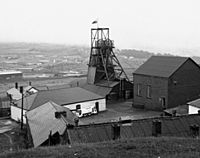Blaenavon Industrial Landscape facts for kids
| UNESCO World Heritage Site | |
|---|---|
 |
|
| Location | Blaenavon, Torfaen, Wales, United Kingdom |
| Criteria | Cultural: (iii), (iv) |
| Inscription | 2000 (24th Session) |
| Area | 3,290 ha (8,100 acres) |
The Blaenavon Industrial Landscape is a very important historical area in Blaenavon, Wales. It has been recognized by UNESCO as a World Heritage Site. This means it's a place of special importance to everyone in the world.
The site includes old coal and iron ore mines, stone quarries, and even an early railway system. You can also see the remains of furnaces where iron was made. The area also shows where the workers lived and how their community was set up. It's like a giant outdoor museum that tells the story of the Industrial Revolution.
Contents
The town of Blaenavon and about 3,290 hectares (which is about 8,130 acres) around it were made a World Heritage Site in the year 2000. This area is very important because it shows how much South Wales helped the world during the 1800s.
During that time, South Wales was a major producer of iron and coal. Blaenavon was at the heart of this industry. The landscape here tells the story of how people mined coal and iron ore, and then turned the ore into iron. This iron was used to build many things, from bridges to machines, helping to change the world.
The site also shows how the workers lived and how their communities grew around the mines and factories. It's a great example of how industrial towns developed and how people lived during a time of huge change.
When you visit the Blaenavon Industrial Landscape, you can see many different parts of its history.
Big Pit National Coal Museum
One of the most famous parts is the Big Pit National Coal Museum. Here, you can go underground into a real coal mine! It helps you understand what life was like for the miners. You can learn about the hard work they did and the tools they used.
Ironworks and Furnaces
The site also has the remains of the Blaenavon Ironworks. This is where iron ore was heated in huge furnaces to make iron. You can see the old furnaces and imagine the heat and noise of the iron-making process. These ironworks were very advanced for their time.
Railways and Tramroads
To move the coal and iron, a network of railways and tramroads was built. These were some of the earliest railways in the world. You can still see parts of these old tracks today, showing how important transport was for the industry.
Workers' Homes and Community
The landscape also includes the homes where the workers and their families lived. You can see how their houses were built and how the community was organized around the industrial sites. This helps us understand the social side of the Industrial Revolution.
Gallery
Related pages
Images for kids
-
Hill's Tramroad leading from the Pwll Du Tunnel to the Garnddyrys Forge. Line above is the leat that carried water from the balancing pond east of Pwll Du to the forge site at Garnddyrys







